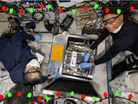Manufacturing Unwrapped: Nasa & Airbus 3D Print in Space

Earlier this year something remarkable happened in the world of space manufacturing.
Airbus, NASA and the European Space Agency (ESA) managed to 3D print the first metal part in space.
While learning about the intense innovation and experimentation needed to reach this milestone, Manufacturing Digital wanted to delve deeper into why its so critical additive manufacturing is possible in space.
This resulted in this piece, which highlights the necessity of 3D printing in making long-duration space exploration a reality.
What are the challenges of 3D printing in space?
The piece highlights how 3D printing is a difficult technology to use in space, due to its physical and environmental properties.
Airbus engineers faced extraordinary challenges in miniaturising a metal 3D printer to fit inside the ISS's Columbus module.
The piece highlights how critical safety was a consideration.
The printer operates in a sealed metal box, carefully managing oxygen levels and using nitrogen to prevent fire risks and metal oxidation.
The temperatures involved are mind-boggling - metal alloys can melt at over 1,200°C, compared to just 200°C for plastic.
Gravity - or the lack of it - presented another significant challenge. The team chose wire-based printing technology, which isn't dependent on gravity like powder-based systems.
They also had to develop methods to capture potentially harmful printing fumes and ensure the ISS's atmosphere remained safe.
Why do we need to be able to 3D print in space?
Imagine being an astronaut on a mission to Mars, and instead of carrying thousands of pounds of spare parts, you can simply print what you need, when you need it.
That's the promise of 3D printing in space.
Currently, the International Space Station (ISS) requires over 7,000 pounds of spare parts annually, with another 39,000 stored on the ground.
But for missions to Mars or the Moon, such a logistics system becomes impractical.
Distributed manufacturing is needed for the future of space exploration, and in this piece we highlight the ways in which 3D printing will make long-duration missions and intergalactic tourism more autonomous, feasible and sustainable.
Why is this article a favourite?
Space is a rapidly evolving and expanding manufacturing focus, with companies like Virgin Galactic looking to the stars for the future of tourism.
Additive manufacturing has so many applications in this area, and the ways in which it could enhance space's accessibility are truly exciting to explore.
From printing wrenches to potentially constructing entire lunar bases using moon dust, 3D printing in this context is so much more than just a manufacturing technology.
It's a symbol of human adaptability, innovation, and our unyielding desire to explore the unknown.
It's cheesy to say, but with 3D printing the stars are no longer the limit - they're just the beginning.
Explore the latest edition of Manufacturing Digital and be part of the conversation at our global conference series, Manufacturing LIVE.
Discover all our upcoming events and secure your tickets today.
Manufacturing Digital is a BizClik brand.


